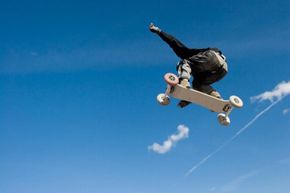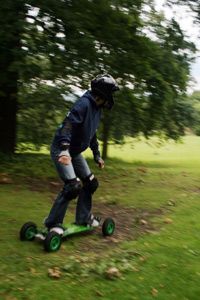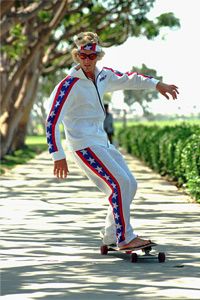For avid snowboarders, summertime is bummer time. The start of the summer season means another six months without waist-high powder, death-defying drops and high-flying half-pipes. For board-sport fanatics, there's some solace in surfing and skateboarding, but nothing quite equals the smooth carving sensation and strapped-in control of snowboarding.
In the early 1990s, a few snowboarding bums in California were looking for a way to beat the summertime blues. They rigged four knobby tires to a snowboard-sized deck, screwed on some modified bindings and started shredding the grassy slopes of off-season ski resorts. Bailing on dirt, grass and gravel proved a bit more painful than snow, but the ride was equally addictive.
Advertisement
Jason Lee, one of these California pioneers, was the first to call the new sport "mountain boarding." Little did he and his buddies know that all across the world, off-season snowboarders were building their own versions of "dirt boards" and "no snow boards." A sports phenomenon was born.
Lee went on to help found MBS Mountain Boards in 1993; the company sold its first mountain boards a year later. Since then, the sport has exploded in popularity as more and more people discover the distinct advantage of mountain boards: you can ride them anywhere at any time.
Mountain boards are extremely rugged, meaning they can maneuver over any terrain imaginable. Mountain boarders can be found on single-track mountain biking trails, on dirt BMX courses, in skate parks, on steep grass hillsides, on gravel roads and city sidewalks.
Not only is mountain boarding great way for snowboarders to keep in riding condition during the off-season, but it has developed its own sports culture, including a thriving competition scene. There are three main types of mountain boarding competitions: downhill, freestyle and boarder-cross.
In downhill mountain boarding, single riders negotiate long courses vying for the best time. In freestyle, it's all about air: Riders take huge jumps, carve rails and pull mind-blowing aerial maneuvers in terrain parks and skate parks. For boarder-cross -- a hybrid of downhill and motocross -- four riders jostle for position as they tear through banked turns and fly over jumps and drops. Technically it's illegal to knock each other over, but the wrecks are half the fun.
When a professional mountain boarder hits a gnarly jump and spins 900 degrees before landing 50 feet (15.2 meters) down the hill, he appears to defy physics. In the next section, we'll look at the scientific principles that make mountain boards work.
Advertisement



